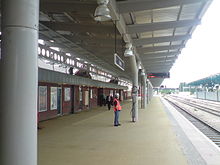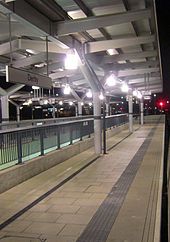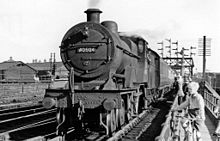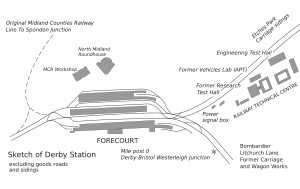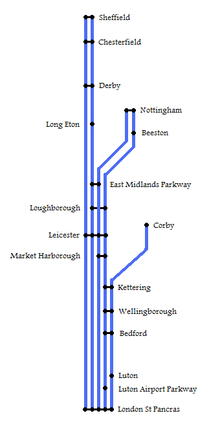- Derby railway station
-
"Derby station" redirects here. For the station in Derby, Connecticut, see Derby-Shelton (Metro-North station).
Derby 
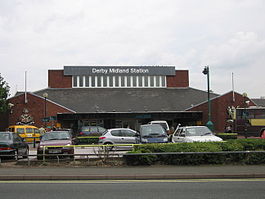
Derby railway station Location Place Derby Local authority City of Derby Grid reference SK362355 Operations Station code DBY Managed by East Midlands Trains Number of platforms 6 Live arrivals/departures and station information
from National Rail EnquiriesAnnual rail passenger usage 2004/05 * 2.624 million 2005/06 *  2.621 million
2.621 million2006/07 *  2.860 million
2.860 million2007/08 *  2.987 million
2.987 million2008/09 *  3.115 million
3.115 million2009/10 *  3.132 million
3.132 millionHistory Original company Midland Counties Railway
Birmingham and Derby Junction Railway
North Midland RailwayPre-grouping Midland Railway Post-grouping London, Midland and Scottish Railway 4 June 1839 MCR temporary station opened 12 August 1839 B&DJR temporary station opened 11 May 1840 NMR permanent station opened as Derby; NCR and B&DJR stations closed 1858 Extended 1871 Extended 25 September 1950 Renamed Derby Midland 1952 Partially rebuilt 6 May 1968 Renamed Derby 1985 Partially rebuilt 2005-2009 Major renovations National Rail - UK railway stations A B C D E F G H I J K L M N O P Q R S T U V W X Y Z * Annual passenger usage based on sales of tickets in stated financial year(s) which end or originate at Derby from Office of Rail Regulation statistics. Please note: methodology may vary year on year. Derby railway station (
 i/ˈdɑrbi/), also known as Derby Midland Station, is a main line railway station serving the city of Derby in England. Owned by Network Rail and managed by East Midlands Trains, the station is also used by CrossCountry services and one Northern Rail service.[1] It is situated to the south-east of Derby city centre, and is close to the west bank of the River Derwent.
i/ˈdɑrbi/), also known as Derby Midland Station, is a main line railway station serving the city of Derby in England. Owned by Network Rail and managed by East Midlands Trains, the station is also used by CrossCountry services and one Northern Rail service.[1] It is situated to the south-east of Derby city centre, and is close to the west bank of the River Derwent.Contents
Overview
Derby's central location and former importance as a 'railway town' have made it an important node of the rail network. First opened in 1844, it was at the time one of the largest in the country and was unusual for being shared by more than one company. Until recently, major carriage and locomotive workshops as well as the Research Division in the Railway Technical Centre were housed there.
The station is an interchange point between the Midland Main Line from London St Pancras to Leeds and long-distance services on the Cross-Country route from Aberdeen through Birmingham New Street to Penzance or Bournemouth (the zero milepost on the latter route is at the south end of platform 1). Until the mid twentieth century, the station was also served by through trains from Manchester and Glasgow to London. It is still a busy station, the section to Sheffield having the highest train frequency (passenger and freight) of any line in the East Midlands.[citation needed]
Local services from Nottingham to Matlock along the Derwent Valley Line serve the station as well as local and semi-fast services to, Stoke-on-Trent, Crewe, Birmingham and Cardiff Central.
Derby station today has six platforms (all but Platform 5 are through platforms), connected by a footbridge, used as an exit to Pride Park and a car park.
History
Early East Midlands railway schemes
After the building of the Stockton and Darlington Railway in 1825, a number of ambitious projects for long-distance lines between cities had been mooted. Among these was a line between London and Edinburgh, for both goods and passengers, via Bedford and Leeds, passing in between Carlisle and Newcastle.
Meanwhile a number of short lines were built for specific purposes. Among these were the Mansfield and Pinxton and the Leicester and Swannington. Both these were feeders for canals, the former a wagonway, but were pivotal in later events. Possibly the longest was the Cromford and High Peak Railway, opened in 1833, to connect the Cromford Canal with the Peak Forest Canal. It attracted interest because it provided access to Manchester through the Peak District of Derbyshire, even today an obstacle to transport.
In the 1830s, lines were already in progress between Bristol and London and from each to Birmingham and thence to Liverpool and Manchester, and their promoters were looking ahead. Three schemes came to the fore for the East Midlands. The Grand Junction Railroad would connect Birmingham with Sheffield and Derby, with a branch to Nottingham and another branch from Sheffield to Manchester. There would also be a line to the East Coast at Goole. In 1824 the London Northern Railroad Company was formed to link Birmingham, Derby, Nottingham, Hull and Manchester with London. Two options were proposed. One would branch at Loughborough, with branches for Nottingham and Derby, and proceeding to Manchester by the Cromford and High Peak Railway. The other option would pass through Northampton, with a branch to Birmingham, go on to Derby, with a branch to Nottingham, and thence to the Cromford and High Peak. The Grand Midland Railway was a proposal to branch from the London to Birmingham railway, already under consideration, at Northampton, and bring it through Leicester, Loughborough and Derby to the Cromford and High Peak.
Towards the end of the 1820s, however, the economic climate of the country had deteriorated, and many investors were waiting to see how the new Liverpool and Manchester Railway would succeed. Moreover, not everyone shared the dream. For most people the canals were adequate for the carriage of goods, while few travelled very far. Most people lived their lives within a few miles of their birthplace. The later story of the railways was a classic one of a product generating a demand, rather than the other way around. Thus, what investment that was forthcoming was for ventures for which a need could be clearly perceived, with a reasonable expectation of a good, and rapid, return. Although the surveys were useful in the planning of later lines, the three were never built.[2]
Derby investors, naturally, favoured the scheme by the Grand Junction Railway to connect to the Cromford and High Peak Railway and Manchester, through Derby (at what was to be called the Grand Central Station), since the London and Northern would pass through Sandiacre, some ten miles away. In the event, neither line was built. In addition, the Cromford and High Peak Railway was not ideally suited to passenger working, and an alternative via Bakewell and Chapel-en-le-Frith would encounter very difficult terrain. (Manchester was not, in fact, reached until later in the century by the Manchester, Buxton, Matlock and Midlands Junction Railway and its extensions.)
Three railways
The Midland Counties Railway was originally proposed to connect the Mansfield and Pinxton Railway to Leicester because of competition to supply coal. However, with the existing canal network, and the navigability of the River Trent to Nottingham, there had been few people willing to invest.[3]
On the other hand, although the River Derwent flowed from Derby into the Trent, navigation was not easy. The Derby Canal had been opened in 1793 but, due to financial restrictions placed on it by Parliament, and the complex local politics of the day it had not been a resounding success. Thus the financiers in Derby vigorously supported any scheme which would bring a railway to the town.
George Hudson was chairman of the York and North Midland Railway, a proposed line from York towards the industrial markets of Manchester and Liverpool. He was interested in a southwards route and encouraged the building of North Midland Railway, later becoming its chairman. Meanwhile financiers in Birmingham, including G.C.Glyn, a banker and chairman of the London and Birmingham Railway, were looking to expand their system. Derby was in between. The Birmingham and Derby Junction Railway would it give a link from Yorkshire to London, and access to the coalfields, as well as other minerals.
Meanwhile the promoters of the Midland Counties Railway found investors further afield, who suggested a line linking Nottingham, Derby and Leicester, with an extension to Rugby for London. Their original plan in 1833 had been to bring their line to Derby at Darby's Yard and Exeter Gardens, at the east side of the present Market Place, with a bridge over the Derwent. Following Vignoles's reassessment in 1835 a new route was proposed, either North or South of the Derby Canal to a terminus near St. Mary's Bridge with a branch to Full Street near to John Lombe's Silk Mill. Both options would cross the North Midland lines north of the other station.[4]
The North Midland planned to build their station near Nottingham Road, avoiding a river bridge, while the Birmingham and Derby planned to build theirs nearby. Possibly with encouragement from the Derby financiers, they realised the value of a link with the North Midland, and decided to bridge the river and share its station. It was usual in those days for new railways to build their own termini, but, while Derby people were enthusiastic about railways, they were less so about a multiplicity of stations. In 1836 the Town Council suggested a single station for all three companies. The Midland Counties engineer pointed out to his financiers that a good deal of money would be saved by joining the other two railways on a single site.
An alternative that was considered was an island bounded by the River Derwent and the canal, called The Holmes, now Bass's Recreation Ground. Not only was the space restricted and susceptible to flooding, the necessary trackwork would be complicated. Eventually, the present site was chosen, further south on the west bank, Borough's Fields, in the neighbouring hamlet of Litchurch, at the southern side of the Castlefields estate.[5] It was a mile from the town, but the Council agreed to build a carriageway to the town centre, along Siddals Lane, now Siddals Road. The whole arrangement was confirmed by the North Midland Railway Act of 1839.
The Tri Junct Station
Although some literature refers to it as the 'Tripartite Station'.[6] it became known as the 'Tri Junct Station',[4][7] It was 1,050 ft (320 m) long with one through platform plus a north and a south bay, the main platform and bays connected to seven stabling roads by a series of carriage turntables (rolling-stock was moved around the station by hand). These platform and stabling roads were all beneath a three-bay train shed.[8]
Whishaw [9] described it thus: "The admirably contrived and elegant roofs, the spacious, the great length of the whole erection extending to upwards of a thousand feet. All unite in rendering it the most complete structure of the kind in the United Kingdom or perhaps the world."
The platform was in three parts with the centre section built forward as in the diagram, which allowed trains some freedom of movement.[10] With one platform for passengers to board and alight, it was not necessary for them to cross running lines when changing trains. The station offices were also partitioned into three sections, each line having its own facilities.
Fronting this was a magnificent two-storey stone building designed by Francis Thompson. The North Midland also built a cluster of workers' houses of which the present Midland Terrace remains preserved as a conservation area.
At each end was a hotel. The Midland Hotel, for first class passengers, is said to be the first provincial railway hotel following on after that at Euston in London.[7] The Brunswick Inn was for second class passengers and railway workers. The saying went that patrons of the first chatted about hunting and shooting, of the other, shunting and hooting.[5]
The first departure from a temporary platform was on 4 June 1839 when a Midland Counties train ran to Nottingham. The first train to Birmingham departed on 12 August in the same year, from another temporary platform further south. The Tri Junct Station finally opened when the North Midland line was completed to Rotherham Masborough on 11 May 1840, reaching Leeds seven weeks later. The station's official name was Derby Station.[11]
Midland Railway
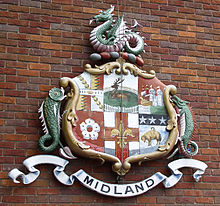 The Midland Railway's coat of arms at the station's entrance
The Midland Railway's coat of arms at the station's entrance
In 1844 all three railways amalgamated to become the Midland Railway, and Derby station became the new company's headquarters. The story goes that Joseph Paxton, a director of the railway, produced his first sketch for the Crystal Palace during a board meeting there.[7] The North Midland had built a repair shop, with the other two building locosheds. These were amalgamated to form the Midland's main locomotive works. Among a number of innovations was the trial of steel rail developed by Robert Forester Mushet in 1857.
In 1846 a north facing spur (Derby North Junction) was added from the Midland Counties line. In 1867 a loop was added to the south, allowing through running for trains from London. The original section remained in occasional use for passenger trains until it was closed in 1969. (What nowadays would be considered the major junction, to the south, is called London Road.)
In 1858 the station was extended with extra offices, improved facilities and a covered areas for carriages for arriving and departing passengers. Traffic increased such that an island platform, the present 2 and 3, was built with, in 1871, Platforms 4 to 6 (Platform 5 being a bay to the south). At this time the turntables were removed and replaced by scissors crossovers, the whole complex controlled by a signal box on the centre platform.[7]
In 1878, the Great Northern Railway opened its "Derbyshire and North Staffordshire Extension" with a station at Derby Friargate Station.
The station and the extensive complex of railway workshops adjoining it were of sufficient strategic importance for them to have been the target of a Zeppelin bombing raid during World War I, in 1916, though only slight damage was inflicted.
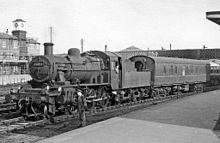 Station Pilot opposite Platform 6 in 1964 with Derby Works in the background
Station Pilot opposite Platform 6 in 1964 with Derby Works in the background
London, Midland and Scottish Railway
Until the Manchester line through Millers Dale was closed in the Beeching era, the 'main line' was that from London to Manchester, carrying named expresses such as the 'Palatine' and the 'Peaks', while trains to Leeds and Scotland tended to use the Erewash Valley Line and expresses to Edinburgh, such as The Waverley travelled through Corby and Nottingham. The line from Leeds was nevertheless busy with trains to the south west and Cornwall, and summer specials to Paignton and Torquay. It had a named express, the 'Devonian', which ran from Bradford to Bristol.
In World War II the station was attacked again, becoming one of the few locations in Derby to suffer significant bomb damage. The overall roof of the train shed and platform six were severely damaged, with the loss of most of the rest of the glass, although the Victorian frontage of the station survived.
British Railways
The station was renamed Derby Midland Station on 25 September 1950.[11]
Comparison of photographs taken of the street side of the station in the early 1900s and the 1970s show little outward change.[original research?] On the track side, however, extensive rebuilding of the platform buildings, footbridge and awnings in 1952, using pre-stressed concrete, gave the station a very different appearance, with simple functional lines. The station signal box was also rebuilt, described by the staff as 'a cupboard under the stairs'.[12]
From 6 May 1968, the station became known as simply Derby on timetables and platforms, though the full name of Derby Midland Station was retained on the station's main sign.[11] Even today, the fuller name is sometimes used, including on the modern main sign (erected 1985) and on the station's electronic departures board.
With the advent of power signalling in 1969, the signal box and the crossovers disappeared, and the tracks approaching the station were relaid to allow trains from any direction to enter or leave any platform.
Further work in 1985 saw the final replacement of the ageing Victorian station entrance and booking hall by a more modern design. The entrance's original clock was moved to the north end of the car park and the coats of arms of the Midland Railway and of the City of Derby were affixed to the new frontage. The decision to demolish the old building was a controversial one at the time.[citation needed]
Post-privatisation
Upon the privatisation of British Rail, the station became owned by Railtrack and later Network Rail, though, in common with most British railway stations, the day-to-day operation is contracted out to the principal user of the station, in this case East Midlands Trains. Prior to November 2007, the station was managed by Midland Mainline, who continued to refurbish the station with the installation of a large electronic departure board in the station entrance hall and smaller boards on all platforms.
In 2005, the footbridge connecting the platforms, which had been temporarily supported for about a decade, was replaced. Whilst doing this, engineers discovered that there were stresses in the concrete of the 1950s canopy. Work to demolish the canopies and erect new ones began in mid 2007 and was completed in October 2009.[13]
Future
As part of Derby's City Centre Eastern Fringes Area Action Plan, plans for new urban village development 'Castleward' suggest a complete overhaul of the rail station's frontage.[14] Plans also focus on a new pedestrian walkway and cycleway routed between the station and the city centre, featuring new retail, residential and commercial developments.[15]
Services
Preceding station  National Rail
National RailFollowing station CrossCountry SheffieldWillingtonCrossCountry Burton upon TrentCrossCountry East Midlands Trains Limited ServiceLimited ServiceTerminus East Midlands Trains Crewe to Derby LineTerminus Limited ServiceTerminus Limited ServiceEast Midlands Trains Northern Rail Nottingham-SheffieldSingle evening departure to SheffieldDisused Railways Terminus Regional Railways Ramsline HaltDuffield Central Trains
Sinfin branch linePeartree References
- ^ http://www.northernrail.org/pdfs/timetables/20081117/33.pdf
- ^ Simmons, J., (1995 ppb ed) The Victorian Railways, London: Thames and Hudson
- ^ Stevenson.P.S. (ed.), (1989). The Midland Counties Railway. Mold: Railway and Canal Historical Society,
- ^ a b Higginson, M, (1989) The Midland Counties Railway: A Pictorial Survey, Derby: Midland Railway Trust.
- ^ a b Heath, J. & Christian, R., (1985). Yesterday's Town: Derby. Buckingham: Barracuda Books,
- ^ Board of Ordnance for the Local Board of Health (1852)Map of the Borough of Derby with portions of Darley, Litchurch and Little Chester, Reprinted 1980 Derbyshire Archaeological Society
- ^ a b c d Billson, P., (1996) Derby and the Midland Railway Derby: Breedon Books
- ^ Pixton, B., (2000) North Midland: Portrait of a Famous Route, Cheltenham: Runpast Publishing
- ^ Whishaw, F, (1840) The Railways of Great Britain and Ireland: Practically described and illustrated London: Simpkin, Marshall and Co.
- ^ Huson, S., (2009) Derbyshire in the age of steam, Newbury: Countryside Books
- ^ a b c Butt, R.V.J., (1995) The Directory of Railway Stations Yeovil: Patrick Stephens
- ^ Harris, D., Signalling around Derby Station
- ^ "NETWORK RAIL INVESTS £18M TO REBUILD DERBY STATION". Network Rail. November 19, 2007. http://www.networkrailmediacentre.co.uk/Content/Detail.asp?ReleaseID=3432&NewsAreaID=2&SearchCategoryID=6/.
- ^ http://www.marketingderby.co.uk/past-present-future/future
- ^ http://www.derby.gov.uk/NR/rdonlyres/487D5E61-34EF-404E-AF7B-AC295FC757EB/0/FINAL_FULL_REPORT.pdf
External links
- Train times and station information for Derby railway station from National Rail
- Map of the station in 1887
- Derby Train Station Information
- Derby Cheap Train Tickets
- Page with more info on the station
- Science and Society: Trackside view of original Station
- Science and Society: 'Derby Railway Station and Midland Hotel', 1840
- "Derbyshire Photographs" Derby Station as it was in 1902
- "Geograph British Isles" Derby Station as it is now
- Derby Midland signalling 1839-2006
Major railway stations in Britain Managed by Network Rail: Managed by train operator: Brighton • Bristol Parkway • Bristol Temple Meads • Cardiff Central • Cardiff Queen Street • Crewe • Doncaster • Glasgow Queen Street • Manchester Victoria • Newcastle • Nottingham • Reading • Sheffield • Southampton • YorkRailway stations of London: Central area | Greater LondonManaged by Network Rail: Managed by train operator: Blackfriars • Clapham Junction • City Thameslink • Marylebone • Moorgate • Stratford • Waterloo EastCategories:- History of Derby
- Railway stations in Derby
- Former Midland Railway stations
- Railway stations opened in 1840
- Railway stations served by East Midlands Trains
- Railway stations served by CrossCountry
- Railway stations served by Northern Rail
- DfT Category B stations
Wikimedia Foundation. 2010.

